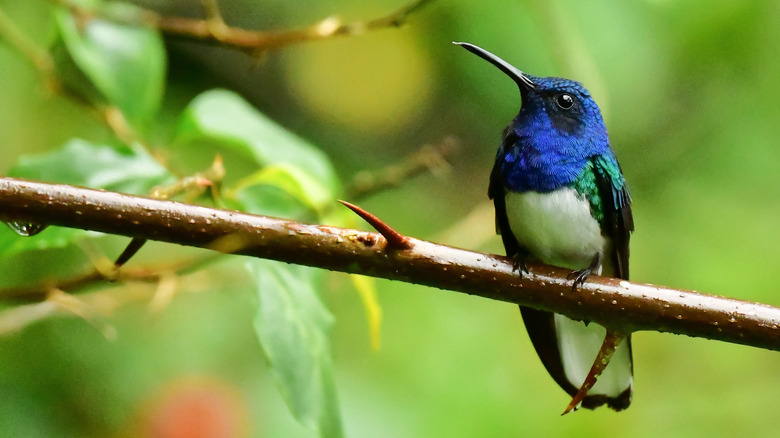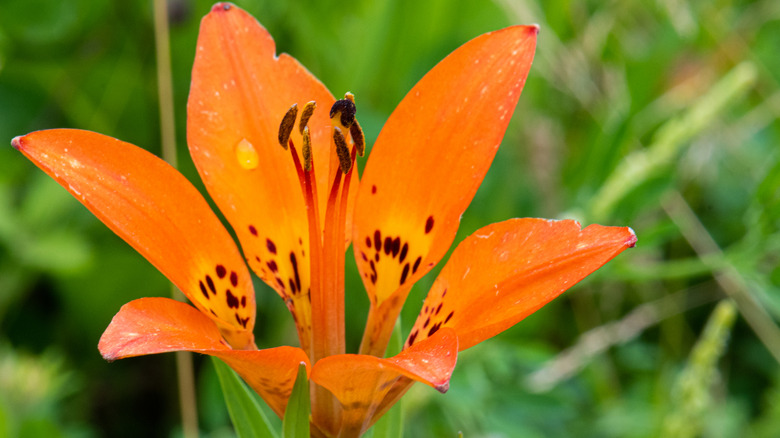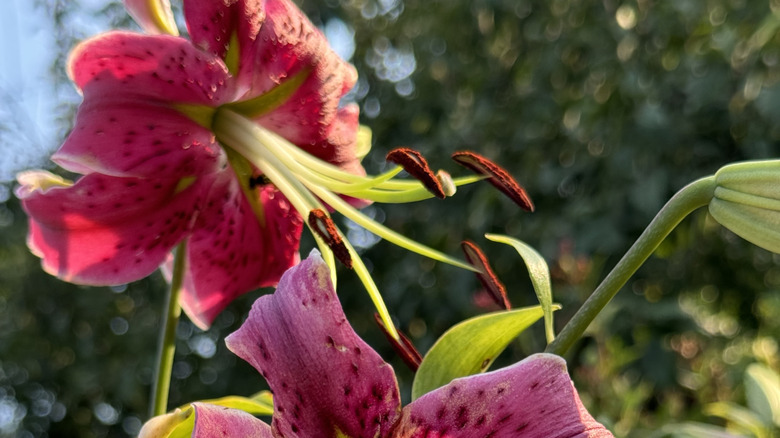Plant These Types Of Lilies To Attract More Hummingbirds To Your Yard
Hummingbirds are unique, fascinating birds and creating a yard that attracts them, aka pollinator gardens, is a delightful way of helping the environment. If hummingbirds are native to your area, there are several types of beautiful hummingbirds you might find in your backyard. You can invite them to your garden by providing perches, insects, and water — or even better, by planting the right type of lilies, like wood lily and Columbian lily.
Did you know that these tiny powerhouses need to visit between 1,000 and 2,000 flowers daily to take in the amount of nectar they need to sustain their crazy metabolic rates? They are drawn to long, tubular flowers as their curved beaks are designed to reach the sweet nectar deep inside the tube. The shape of many lilies sits in the sweet spot of that requirement. When it comes to choosing colors, opt for flowers with vivid hues such as red, orange, purple, or yellow. Brightly colored blooms attract fast-flying hummingbirds to their next nectar stop. Just a word of caution for cat lovers: many lilies are toxic to felines.
Choose native lilies for the best nectar
Add a fiery pop of color to your Northeast to Midwest garden with the charming Lilium philadelphicum, commonly known as a wood lily. While most native lilies have hanging blooms, this orange beauty is one of the few that face the sky with upturned flowers. They're versatile for areas as they prefer semi-shade to full sun beds. Reaching 1 to 3 feet tall, you can use them to add life and fullness to your borders among other beautiful flowers that grow perfectly in shade. They're suitable for USDA hardiness zones 4 to 7.
Western gardens are ideal for the dappled amber beauty of Lilium columbianum, or Columbian lily. These freckled blooms love moist soil. They are sun loving, but will tolerate light shade. Under the right conditions, you'll have a riot of colorful blooms between June and August. Those in USDA zones 5 to 10 can grow Columbian Lilies.
Planting lilies that are naturally found in your area is one of the best things you can do for your hummingbird buddies. As native plants, they should produce sufficient nectar and be relatively easy to grow. As part of the regions natural biodiversity, they've adapted to the climate, soil, and growing conditions, and should thrive without needing special attention. Check with your local garden center for more lilies that are native to your area.
Hybrid hummingbird-friendly lilies to plant in your yard
Hybrid lilies are created by cross-pollinating two different types of plants. This is done to enhance chosen qualities such as resilience, size, or flowering capacity. When it comes to flowers, hybrids are often created for aesthetics, but this can reduce the plant's suitability as a source of nourishment for hummingbirds. Some double blooms look exquisite, but either don't produce enough nectar or are the wrong shape for the tiny birds' feeding habits. However, there are some hummingbird-friendly hybrids to consider.
The Lilium 'Black Beauty' is a show-stopping dark crimson lily that flowers mid to late summer and grows 4 to 7 feet tall. This elegant hybrid is a vigorous grower and will reward you with 50 to 150 flowers per stem. They'll soak up partial to full sun and prefer well-drained, moist soil. If you live in USDA hardiness zones 4 to 9, you've hit the lily jackpot as this stunner is suited to your area.
To add a touch of sunny yellow to the best spot in your garden to plant lilies, pick the Lilium 'Conca d'Or', a trumpet lily with huge lemony-white petals. These perennials love full sun with a touch of shade and grow to a height of 5 feet. They thrive in well-drained, rich soil so you can fertilize them every two weeks with organic matter. USDA hardiness zones 4 to 8 are ideal for these hummingbird-attracting hybrids.


